Cactus RF60 Review
Handling
The RF60 is a pure joy to handle. Testing the RF60 was not a chore at all; on the contrary, I sometimes picked it up just to experience the very satisfying handling again. This sounds silly, but I challenge you to not do the same, once you have used an RF60. :)
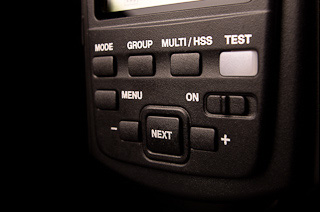 |
| Superiour buttons The buttons are extremely satisfying to use. |
One big contributor to making the RF60 fun to use are the extremely nice buttons. They have a very good pressure point, providing both tactile and audio feedback when one presses them. Not once did I experience a failure of a button to respond to a press or an unwanted double activation. The RF60’s buttons are superior to the buttons on both Canon 540EZ and Metz 58 AF-2.
Another contributor is the very thought through user interface that minimises button presses and avoids double button and/or long button presses as much as possible. As a result, one can very quickly change all important settings and quickly navigate to others, if necessary. While there are some typical cycles left – e.g., the “MODE” button cycles through “Local”, “Slave” and “Master” modes – it is always possible to adjust values both up and down with the “+” and “-” keys respectively and without ever needing to explicitly enter an adjustment mode or confirm the new value. Overall, this allows for very quick adjustments.
Being able to adjust power levels in 1/3 stop increments as opposed to the full stop increments older manual flashes supported is very welcome as a full stop jump is often too big when it comes to fine tuning the lighting ratios of multiple flashes.
There are many nice touches to the user interface, such as the fact that changes made in the menu directly apply without the need to confirm values or even exit the menu. For instance, finding the correct “Delay” value for emulating second curtain sync (see section “Special Features”) thus becomes much easier.
The total LCD area of the RF60 is smaller than that of the Canon 540EZ and the Metz 58 AF-2, however, important information such as the power level and the zoom setting is shown with larger characters so that overall, readability is better on the RF60. The RF60 uses a segment LCD which looks more elegant than a pixel-based LCD, but can be limiting as well, as some areas can only display numbers but not letters. The RF60 nevertheless manages to display rather self-explanatory menu items, in stark contrast to the very cryptic character sequences of a Yongnuou YN560-III, for instance.
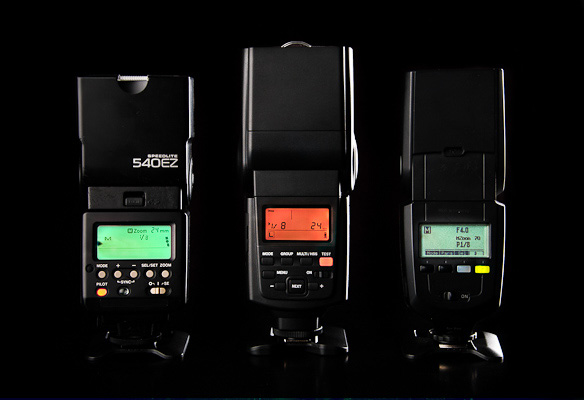 |
| LCD Display All displays show the power level (1/8) and the zoom setting (24mm; 70mm for the Metz). |
One of the very useful indicators on the LCD panel is the battery level indicator. It is unfortunately optimised to work best with Alkaline batteries as opposed to NiMH rechargeables, but it nevertheless leaves one less in the dark as to when batteries should be replaced.
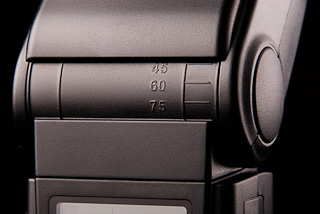 |
| Swivel & Tilt head Click stops help to replicate common angle settings. |
The RF60’s flash head can both tilt and swivel. Luckily there are click stops but no locks, i.e., it is not necessary to press any buttons before one can adjust the angles. Such locks typically only work for extreme angle positions and are very annoying most of the time, requiring one to use two hands or contort one hand into pressing a button and turn the head at the same time.
Unfortunately, the flash head does not support a slight downward tilt when facing forward. Such a slight downward tilt would have helped to centre the illumination within the frame when using the flash on-camera and/or better aim at the centre of umbrellas in certain mounting contexts. It appears that supporting this slight downward tilt would have complicated the swivel mechanism since the downward tilt must automatically be reset when the head is swivelled in order to avoid a collision of the head with the flash body.
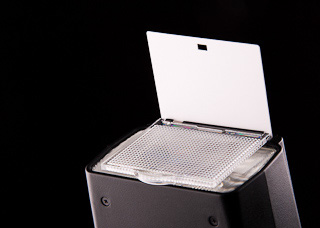 |
| Diffusor panel & bounce card The diffusor further increases the wide angle range. |
The workarounds for the aforementioned challenges – i.e., using a slightly tighter framing or using more flexible mounting options respectively – are rather acceptable though.
In terms of size, the head is comparable with other powerful flashes and thus fits into standard light modifiers such as the ORBIS ringlight.
The flash head also features a built-in diffusor panel and a bounce card. The former further expands the wide angle while the latter can help to avoid racoon eyes and/or create catch lights when the flash is used to bounce of walls or ceilings.
 |
| Battery Compartment Helpful orientation indicators. |
The battery door is very similar to that of the Metz 58 AF-2 and much, much easier to handle than that of the Canon 540EZ. While it is not spring-loaded and does not open beyond 90° it still allows removal and insertion of all four cells in one go and promises to allow trouble free operation with its pretty sturdy construction and tight fit. The correct orientation of the cells is indicated on the inside of the battery compartment.
The built-in radio receiver improves handling in many ways:
- No extra receiver dangles from the external sync-port or compromises the mounting stability when using hot-shoe based mounting.
- There is no need to carry an additional receiver in the bag and connect it to the flash.
- There is no need to make sure the receiver’s battery level is still usable.
- Power levels and even zoom settings can be remote controlled.
Cactus V6 Trigger
Since the upcoming Cactus V6 radio trigger can also remote control power levels, it will be a natural choice as an on-camera controller for one or more off-camera RF60. The big news is that the V6 will also be able to remote control the power of a large number of digital TTL flashes for the Canon, Nikon, and Pentax flash systems!
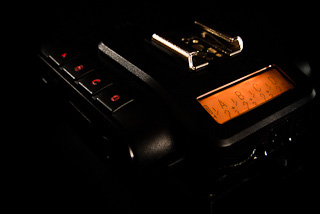 |
| V6 Engineering Sample In combination the RF60 and the V6 are a strong team. The pictured engineering sample does not feature the final finish; the production version may differ in other ways as well. |
The V6 will feature over 30 predefined flash profiles to accurately set the power of modern flashes like the Pentax AF 360FGZ, Pentax 540FGZ, Metz 58 AF-2, etc, and older film style TTL flashes such as the Canon 540EZ. It will thus be possible to control these flashes with a V6 or a RF60 in “Master” mode as if they were RF60 flashes.
UPDATE: Even if your particular old film-style TTL flash model is not supported out of the box, you will be able to create a flash profile for it yourself, as long as the flash is TTL-capable, has manual levels, and has a Canon, Nikon, or Pentax hot-shoe.
You will even be able to adjust the power of such flashes in 1/10 EV steps, independently of what brand your TTL flash is! Beyond that, the V6 will have an "absolute power" mode in which one can specify absolute power targets for any flash, independently of its maximum power. You will never have to wonder again what power fraction to choose on a GN48 flash if you want to match 1/4 power on a GN56 flash. The V6 will make the calculations for you.
The V6 will therefore be the most powerful, completely brand-agnostic trigger on the market. Even its TTL-pass-through hot-shoe is brand-agnostic as it works for Canon, Fujifilm, Nikon, Olympus, Panasonic, and Pentax hot-shoe layouts alike!


